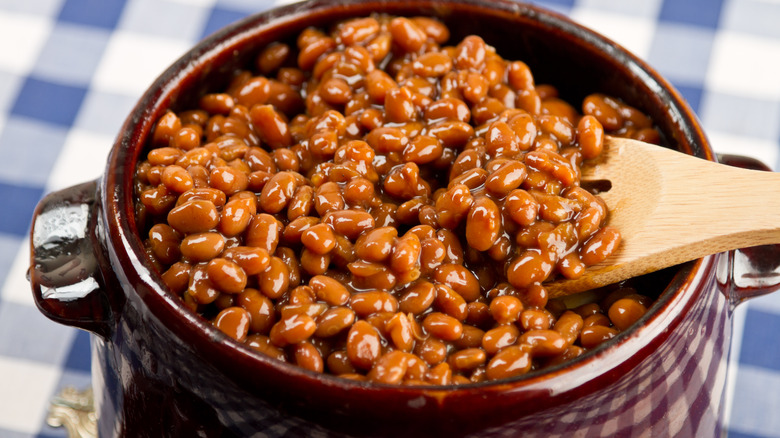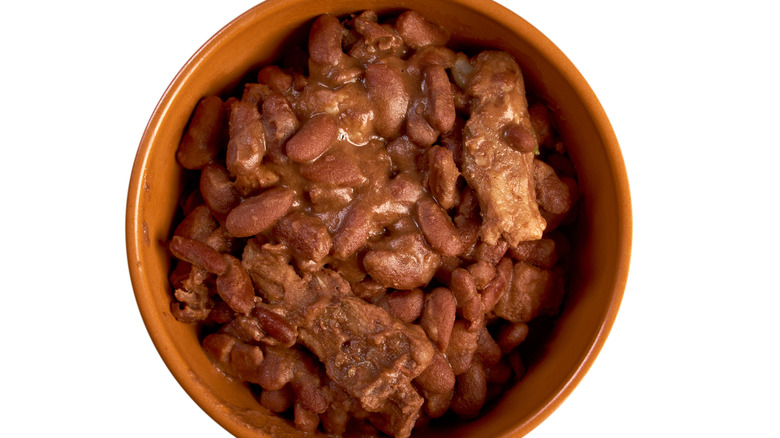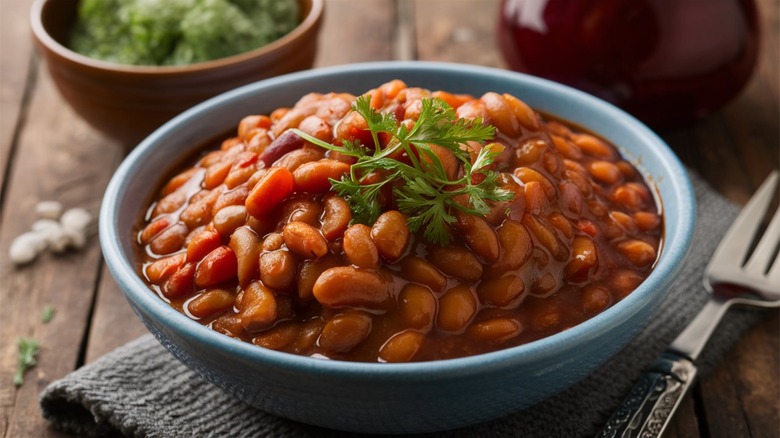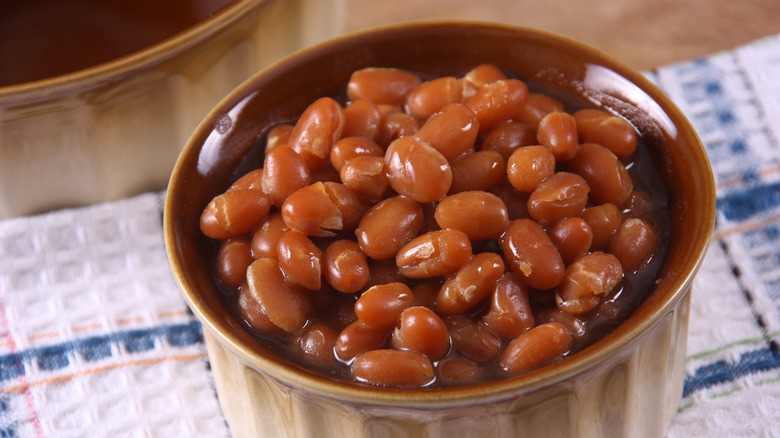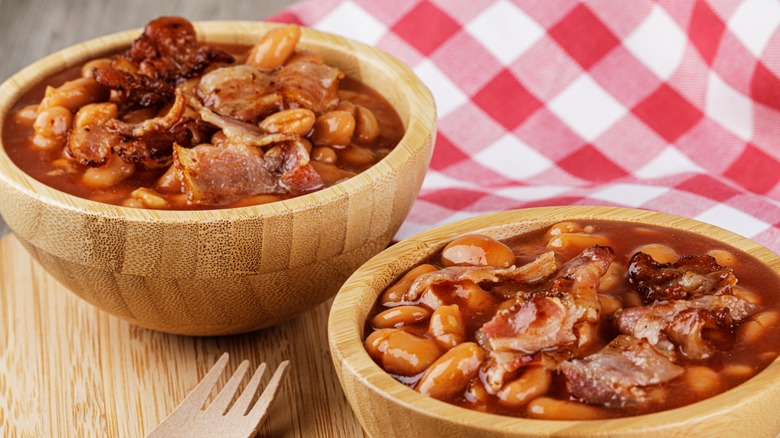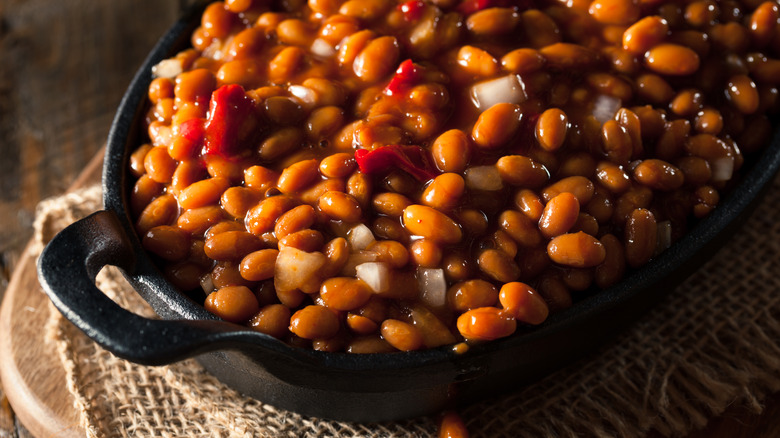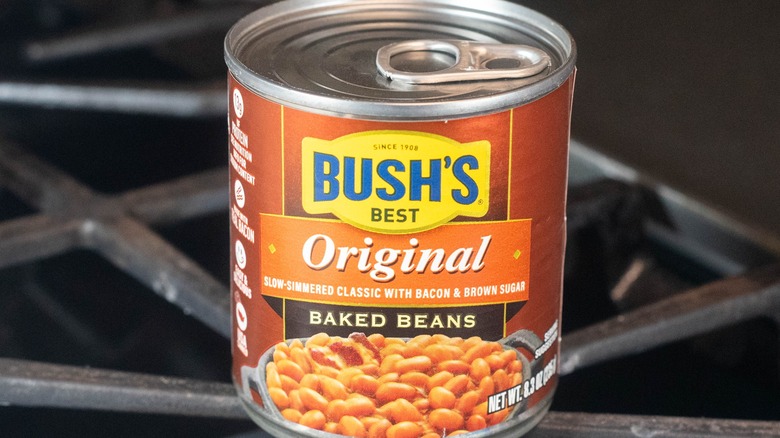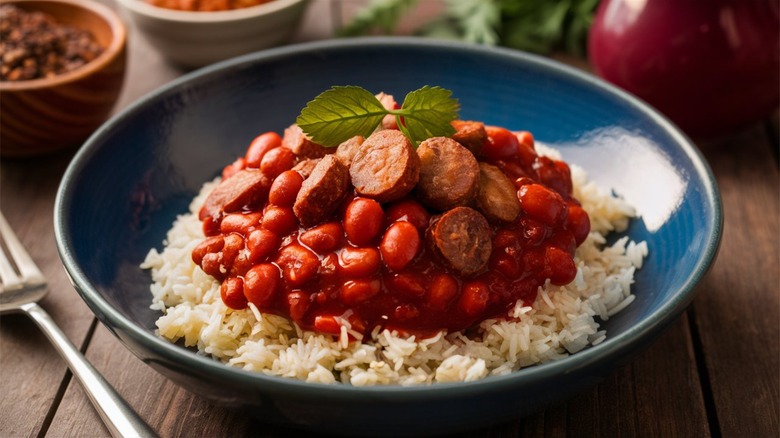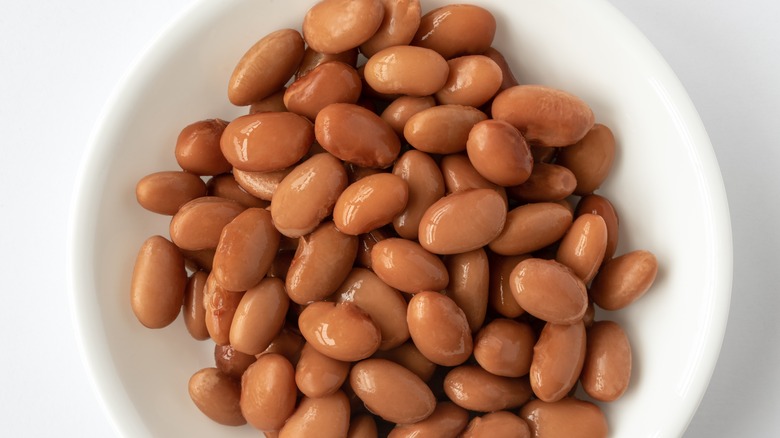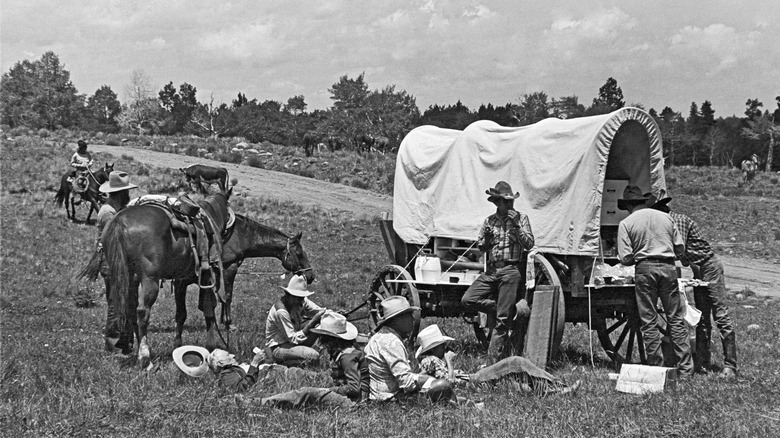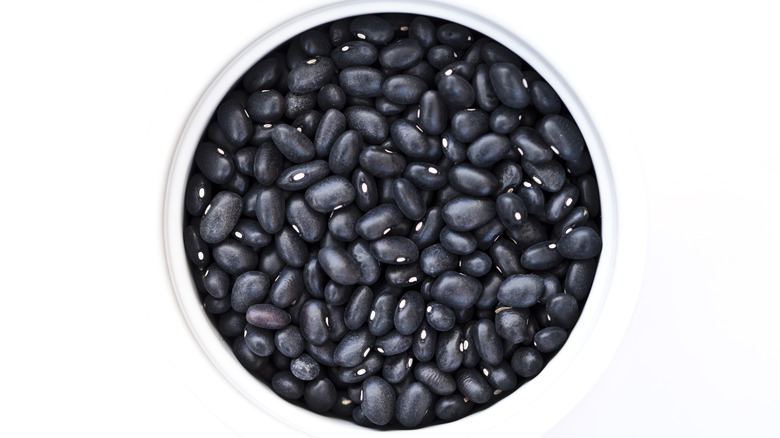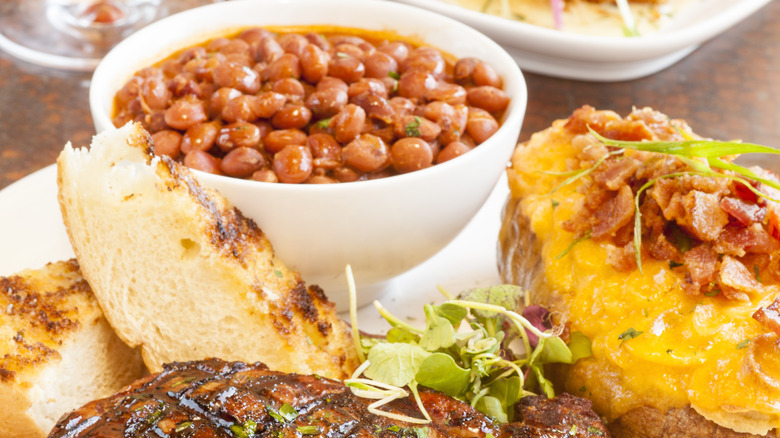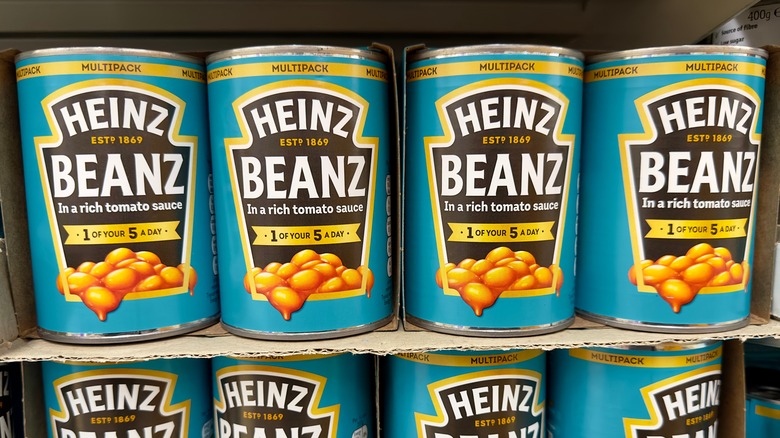Different Regional Styles Of Baked Beans, Explained
The term "baked beans" might seem like it does what it says on the tin, but the truth is that depending on where you are, the phrase may refer to any number of different recipes, sweet or savory, saucy or spicy, according to celebrity chef Andrew Zimmern. "From the central coast of California, where they make a pinquito bean, which is a very small bean, often served at big grill-outs with their big grill-outs with their tri-tip steaks, to North Carolina, Memphis-style, Southern-style, obscure Southern styles, where they actually put barbecued meats in them," he says, "baked black beans, which I'm extremely fond of, Louisiana red beans that are sometimes baked and put over rice, one of my favorites ... I think I've eaten them all!"
For Zimmern, each style of baked beans has its qualities and unique attributes. Indeed, he says that the only essential unifying factor is that the beans themselves be treated with care. "Beans that I think make the best baked beans are the ones where the cook doesn't let them linger for too long," he says. "Beans are forgiving, but there is that beautiful place where beans are just perfect: soft and tender, but holding together, that I absolutely love."
If you agree, here are the different regional styles of baked beans you should definitely consider giving a try.
Boston baked beans
Boston is well deserving of its nickname of Beantown: Baked beans here have a long history. The first baked beans were probably cooked by local indigenous populations, and during Colonial times, European settlers adopted these recipes, simmering beans slowly on the hearth to keep from disobeying rules against cooking on the sabbath. Some sources claim that these baked beans have roots in medieval English dishes, such as bean and bacon pottage.
Modern recipes typically take advantage of the molasses that sweetened these early Boston baked bean recipes beginning in the mid-18th century, when the sugarcane byproduct produced by enslaved people in the Caribbean became prevalent in New England due to Boston's increasing centrality in the sugar trade. Boston baked beans also typically feature salt pork, a nod to the meat scraps that would have flavored these original recipes, born in times of austerity. Standing out from other New England recipes, Boston baked beans typically use smaller pea beans and might be served with hot dogs or homemade bread. While traditional versions of the dish must simmer for hours, slow cooker Boston baked beans come together with very little effort.
Maine baked beans
The history of Maine's baked bean tradition links the dish to local logging camps, where cast-iron pots of beans were lowered into an aptly named "bean hole" — a fire pit lined with stones into which a cast iron bean pot could be lowered to slowly bake overnight. The resulting beans are a bit more toothsome than Boston baked beans — at least according to a quote Serious Eats attributes to a Lewiston, Maine newspaper, which reported the latter resemble more of "a sort of brown paste with small nubbly particles in it" that might be more aptly called "bean butter."
While this discrepancy isn't widespread in descriptions of the two dishes, the difference could be down, not to preference or recipe, but rather the beans Mainers use. As opposed to Boston baked beans, typically made with white navy or pea beans, yellow-eye beans are far more popular.These heirloom beans are not dissimilar to navy or great northern beans, but they hold up better to the hours-long cooking process, ensuring that they remain toothsome yet creamy. They also stand out with their beautiful pop of color. Aside from bean type, the recipes are indeed fairly similar — no surprise, considering the geographical proximity of Massachusetts and Maine. Like Boston baked beans, Maine baked beans are typically sweetened — with molasses, brown sugar, or maple syrup — and they usually feature salt pork.
Canadian baked beans
Just north of the American border, Canadian cooks have their own plays on baked beans just as laudable as those found to the South. Indeed, some experts claim baked beans are one of the only truly native Canadian dishes, beginning with indigenous recipes cooked in earthenware pots that were eventually adapted by English and French settlers. Some even point to French cassoulet as an inspiration for Canadian baked beans. By 1956, baked beans had become so popular in Canada that the head chef of the Royal York Hotel in Toronto quipped that they should be the country's national dish.
With such a massive geographical span, there's no surprise that there are many regional variations of baked beans across Canada. Many are sweetened with one of Canada's prime exports: maple syrup. In Quebec, they are usually boiled with pork and are called fèves au lard, while in Newfoundland, they're often paired with toutons, a fried bread cake native to the region. No matter how you dish them up, they're delicious.
North Carolina baked beans
Southern styles of baked beans tend to be both meatier and sweeter than New England recipes thanks to their reliance on ketchup in addition to molasses and/or brown sugar. Usually made with navy beans, Southern baked beans are typically slowly cooked with smoky bacon, which is appropriate seeing as they are often a side dish to one of the South's staple foods: barbecue.
North Carolina's barbecue stands out thanks to its vinegar-forward barbecue sauce, and the Tar Heel state is known just as much for its sides. North Carolina baked beans are a stalwart, typically simmered in a richly flavored sauce seasoned with spices and liquid smoke, sweetened with honey and corn syrup, and, of course, boasting a bit of a zing thanks to the addition of vinegar. Some North Carolina-style baked beans also feature pork, like browned and crumbled country-style sausage, which make them even more savory and rich. Some versions of Southern baked beans double down on the meatiness of this recipe, relying on canned pork and beans as a base. This also makes the recipe quicker to pull together than if you were starting with soaked dry beans.
Kansas City baked beans
Kansas City has long been a barbecue capital, a tradition dating back to Henry Perry, who sold meat cooked in an outdoor pit near his streetcar barn. These days, Kansas City barbecue is above all known for its sauce, which is sweet and thick, adorning myriad meats from beef to pork to chicken. There's even a society awarding prizes to the very best Kansas City-style barbecue around the world.
The sweet-and-savory flavors of Kansas City barbecue also find their way into the typical sides, including the smoky baked beans preferred in the region. Indeed, many recipes for Kansas City baked beans begin with Kansas City barbecue sauce as a base. Paired with molasses, ketchup, and brown sugar, the resulting sauce — and beans — are definitely on the sweeter side. But when you add aromatics like garlic and scraps of brisket or bacon, you ensure the resulting dish is also savory and rich.
Memphis baked beans
Memphis is yet another barbecue capital known for known for its slow-cooked pit-style pork with loads of smoky flavor. Here too, baked beans are a common barbecue side dish — and no two recipes are alike. Some come with bits of pulled pork mixed into the beans; some are simmered in house barbecue sauce. Some even add spicy jalapeños to the mix.
Perhaps the most famous baked beans in America come from Tennessee: Bush's Best. You can even visit a museum in Chestnut Hill dedicated to them. The label on the can claims they're simmered with bacon and brown sugar, but aside from that, the recipe is top secret. Luckily, that's not the case of all Memphis baked beans. Beale Street baked beans see pinto beans paired with browned ground beef, onion, and a sweet-and-savory sauce made with ketchup, brown sugar, Worcestershire sauce, and dried mustard. They stand out from many others in the way they're served: not as a side dish, but rather as an appetizer with corn chips for dipping.
New Orleans baked beans
Louisiana's baked beans are a favorite of Zimmern's thanks to their savory bent. Indeed, unlike many other regional styles of baked beans, Louisiana's approach tends to be more savory and even more pork-forward than other Southern styles, with some Louisiana-style baked bean recipes featuring up to three kinds of pork, from bacon to tasso to andouille. Unsurprisingly, given the prevalence of spice in the local cuisine, the sauce for these beans typically packs a flavor punch that features cayenne pepper, garlic, and more.
But don't confuse Louisiana baked beans with another local bean dish. Red beans and rice is a horse of a different color: a slow-simmered specialty pairing red kidney beans with ham hocks and pork belly for a richly flavorful stew served, as its name suggests, over perfectly cooked white rice. The dish is a Monday night staple in the region, seeing as Monday was typically laundry day, and the slow-cooked specialty could simmer for hours without needing much attention while the woman of the house took care of the washing for the week.
Tex-Mex baked beans
Texas-style baked beans stand out from styles popular in the east thanks to their big, bold, savory flavors. Texas-style baked beans are typically generously flavored with bacon and aromatics like onions, peppers, and garlic. And some versions of the recipe even call for dark lager to add even more depth and richness. Rounded out with a host of spices like chili powder, paprika, cumin, cayenne, or even smoky chipotle pepper, and these beans live up to Texas' bigger-than-life reputation.
Texas-style baked beans typically rely on pinto beans, a bean variety long cultivated by the Mayans and Aztecs. A long-time staple of Texan and Mexican kitchens, pinto beans stand out with their pretty orange-pink color mottled with flecks of darker orange. With their creamy texture and relatively consequential size, these beans they cook up nutty and richly flavorful. Plus, according to Zimmern, "pintos hold together great," meaning that even if you forget them on the range, they're likely to be forgiving.
Cowboy beans
Another style of baked beans native to Texas is cowboy beans, which are also sometimes known as chuck wagon beans, due to their origins on chuck wagons. These ancestors of food carts were invented by Charles Goodnight in 1866 as a means of feeding the cowboys driving 2,000 longhorns from Texas to Colorado. Soon they became a staple of drives across the Wild West, serving cowboys three hot meals a day, from biscuits to slow-simmered beans.
Cowboy beans understandably rely on ingredients that chuck wagon cooks would have had easy access to as they followed cowpokes across the plains. Pinto beans are once again the bean of choice, typically simmered with chiles and ham hocks. Some recipes are even heartier, adding ground beef to the beans for even more protein. Either way, the resulting beans are richly savory, smoky, and just a bit spicy — the perfect restorative dish for any cowboy after a long day of cow herding.
Southwestern black beans
For Zimmern, there's another regional style of baked beans in the Southwest that stands out as one of his all-time favorites. Alongside the beans from Louisiana, Southwestern black beans are tied for first as one of his all-time favorite styles, he says, "because they're not sweet." Zimmern prefers his beans "spicier than sweeter," and this style of baked beans is both spicy and savory. Indeed, unlike some other regional baked bean recipes, Southwestern black beans don't feature any sugar at all.
Southwestern baked beans begin with an aromatic base of red onion, garlic, and spices like chili powder and cumin. This seasoning is perfect for dense, velvety black beans, which become fudgy and thick the longer they cook. Cilantro and lime juice are the perfect finishing touches, adding vibrancy and freshness to the dish. Zimmern notes that some versions of Southwestern black beans can also feature pork products, like ham hocks, to add even more smokiness and substance.
Santa Maria-style baked beans
Another of Zimmern's favorite baked bean styles is the Santa Maria style, typically served alongside Santa Maria-style barbecue, a long-standing tradition born on local ranches that remains stalwart in its popularity even today. Santa Maria-style barbecue stands out from barbecue styles to the south and east in its relative simplicity: Grilled tri-tip steak is paired with fresh salsa and local staple pinquito beans, renowned on the central California coast for their unique texture and flavor.
The tiny pink beans are no bigger than a lentil, and their origins are somewhat mysterious. Some say they originally hail from Spain; others claim they came from south of the border. Either way, they're difficult to find outside of California, though fans can order them online from Rancho Gordo. This specific bean is essential to the success of the recipe, which sees them paired with bacon, Anaheim chile, and ancho chile powder and slowly cooked until they become tender and creamy (but never mushy), and render a beautifully meaty broth that pairs perfectly with tri-tip steak.
British baked beans
Across the pond, baked beans are a particular comfort food to Brits, who enjoy them more as a main than a side dish. Frequently served on toast or in jacket potatoes, as a saucy accompaniment to a "full English" breakfast or even on potato waffles, baked beans are a staple for sure. Of all the available brands in British supermarkets, Heinz is the reigning champ. So it's perhaps no surprise that it was Henry Heinz who introduced them to the Brits in the first place. The American businessman brought his beans to Britain in 1901, and soon, Brits were eating more baked beans than anyone else around the world.
Despite their American origins, British baked beans stand out from versions in the U.S. or Canada in that they are simmered in a savory, tomato-based sauce that's thinner than most American baked bean sauces. British baked beans are also typically vegetarian.
Static Media owns and operates Tasting Table and Mashed.
